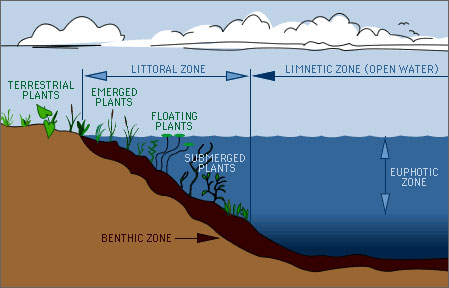Inland lake habitats critical to maintaining healthy lake ecosystems
Understanding the five distinct lake zones and the habitats they provide is key to restoring or maintaining lake ecosystem health.
 At first glance, an inland lake shoreline might look pretty plain. Plants may be clearly visible in the water; other plants may be growing inside the water, but are not clearly visible below the water. Some fish and wildlife species may be obvious while others may not. However, upon further investigation, inland lakes are very diverse and provide diverse habitats or places where species get what they need to survive including food, water, cover and a place to raise their young.
At first glance, an inland lake shoreline might look pretty plain. Plants may be clearly visible in the water; other plants may be growing inside the water, but are not clearly visible below the water. Some fish and wildlife species may be obvious while others may not. However, upon further investigation, inland lakes are very diverse and provide diverse habitats or places where species get what they need to survive including food, water, cover and a place to raise their young.
A lake can be divided based on many different criteria. One such criterion is based on temperature. A lake can also be divided into distinct areas based on the extent of sunlight penetration into the lake. The amount of light in turn determines the type of plants in each zone. Because each lake is different, the depth of the individual lake will help determine the size and influence of each zone.
With regard to light penetration, a lake can have five distinct zones:
Euphotic zone refers to the area in the water from the surface down to the depth where light becomes too low for organisms to be able to undergo the process of photosynthesis. This exact depth varies, since it is dependent on water clarity. In Michigan, this could be anywhere from 8 to more than 30 feet deep. The euphotic zone has two subzones:
- Littoral zone refers to the nearshore area that is the shallow and warmest part of the lake where sunlight penetrates all the way to the bottom sediments and allows rooted aquatic plants, or macrophytes, and attached algae to grow. This zone is most affected by changes at the shoreline.
- Limnetic zone refers to the area of open water where the lake is too deep to allow rooted plant growth. Instead, this zone contains a variety of free-floating organisms such as phytoplankton and zooplankton. Stronger swimmers such as fish can utilize the limnetic zone as well as the littoral zone.
Profundal zone refers to the area in a deep lake where no light reaches, so photosynthesis is not possible there. Biological activity in the form of bacteria use oxygen to break down organic matter. Some profundal zones can be completely devoid of oxygen, which results in few to no animals using this area of the lake.
Benthic Zone refers to bottom sediment where a diverse variety of activities take place. The lake bottom may be made up of sand, mud, marl and/or a mixture of any or all of these materials. The organic sediment serves as a nursery, refuge and foraging area for fish, amphibians, birds, aquatic insects and crustaceans. Some benthic macroinvertebrates, such as dragonfly larvae, can spend up to three years in the bottom sediment before becoming adults and emerging from the lake. Changes that occur in the benthic zone of the littoral zone are sensitive to shoreline development and can result in reduced food sources, spawning and safety areas. Typically, reduced diversity in this zone results in a reduction in fish populations. The productivity of this area partially depends on the organic content of the sediment, the amount of physical structure, and in some cases, the rate of fish predation.
In short, each zone supports various plants and animals. Even slight changes to one or more of these lake zones can result in reduced habitat, which can impact the entire lake ecosystem.
The “Citizen’s Guide for the Identification, Mapping and Management of the Common Rooted Aquatic Plants of Michigan Lakes,” Michigan State University Extension bulletin #WQ55, is a helpful resource to help identify rooted aquatic plants. It is available for sale through the MSU Extension Bookstore.
For more information on lake zones, visit University of Minnesota-Duluth’s Water on the Web website.



 Print
Print Email
Email




